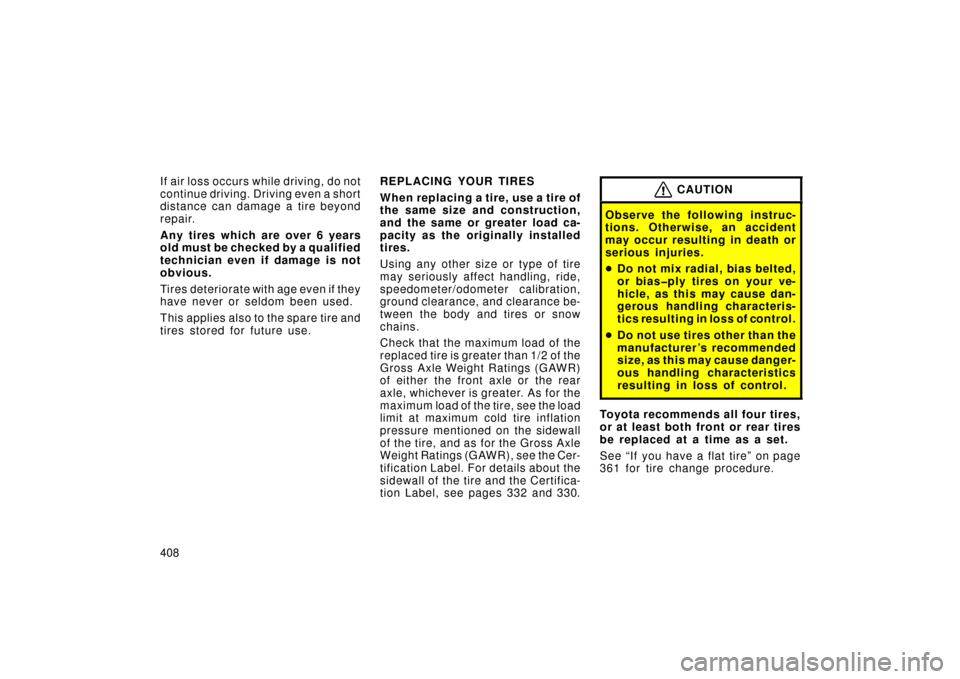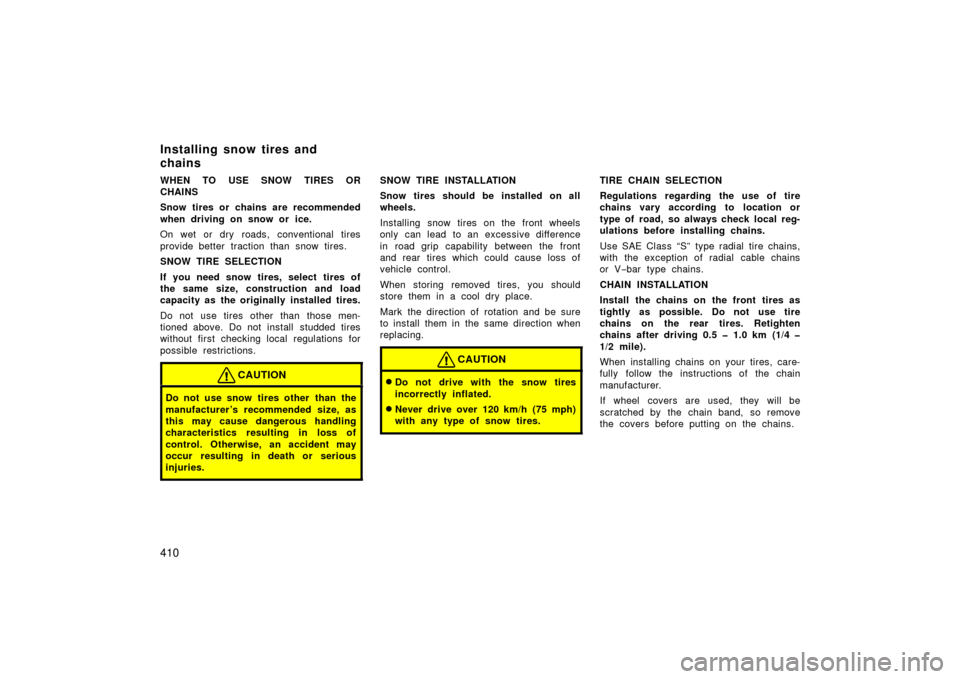Page 408 of 455

408 If air loss occurs while driving, do not
continue driving. Driving even a short
distance can damage a tire beyond
repair.
An y ti res wh i ch are over 6 years
old must be checked by a qualified
technician even if damage is not
obvious.
Tires deteriorate with age even if they
have never or seldom been used.
This applies also to the spare tire and
tires stored for future use.REPLACING YOUR TIRES
When replacing a tire, use a tire of
the same size and construction,
and the same or greater load ca-
pacity as the originally installed
tires.
Using any other size or type of tire
may seriously affect handling, ride,
speedometer/odometer calibration,
ground clearance, and clearance be-
tween the body and tires or snow
chains.
Check that the maximum load of the
replaced tire is greater than 1/2 of the
Gross Axle Weight Ratings (GAWR)
of either the front axle or the rear
axle, whichever is greater. As for the
maximum load of the tire, see the load
limit at maximum cold tire inflation
pressure mentioned on the sidewall
of the tire, and as for the Gross Axle
Weight Ratings (GAWR), see the Cer-
tification Label. For details about the
sidewall of the tire and the Certifica-
tion Label, see pages 332 and 330.
CAUTION
Observe the following instruc-
tions. Otherwise, an accident
may occur resulting in death or
serious injuries.
�
Do not mix radial, bias belted,
or bias�ply tires on your ve-
hicle, as this may cause dan-
gerous handling characteris-
tics resulting in loss of control.
� Do not use tires other than the
manufacturer’s recommended
size, as this may cause danger-
ous handling characteristics
resulting in loss of control.
Toyota recommends all four tires,
or at least both front or rear tires
be replaced at a time as a set.
See “If you have a flat tire” on page
361 for tire change procedure.
Page 410 of 455

410
WHEN TO USE SNOW TIRES OR
CHAINS
Snow tires or chains are recommended
when driving on snow or ice.
On wet or dry roads, conventional tires
provide better traction than snow tires.
SNOW TIRE SELECTION
If you need snow tires, select tires of
the same size, construction and load
capacity as the originally installed tires.
Do not use tires other than those men-
tioned above. Do not install studded tires
without first checking local regulations for
possible restrictions.
CAUTION
Do not use snow tires other than the
manufacturer ’s recommended size, as
this may cause dangerous handling
characteristics resulting in loss of
control. Otherwise, an accident may
occur resulting in death or serious
injuries.
SNOW TIRE INSTALLATION
Snow tires should be installed on all
wheels.
Installing snow tires on the front wheels
only can lead to an excessive difference
in road grip capability between the front
and rear tires which could cause loss of
vehicle control.
When storing removed tires, you should
store them in a cool dry place.
Mark the direction of rotation and be sure
to install them in the same direction when
replacing.
CAUTION
�Do not drive with the snow tires
incorrectly inflated.
�Never drive over 120 km/h (75 mph)
with any type of snow tires.
TIRE CHAIN SELECTION
Regulations regarding the use of tire
chains vary according to location or
type of road, so always check local reg-
ulations before installing chains.
Use SAE Class “S” type radial tire chains,
with the exception of radial cable chains
or V−bar type chains.
CHAIN INSTALLATION
Install the chains on the front tires as
tightly as possible. Do not use tire
chains on the rear tires. Retighten
chains after driving 0.5 � 1.0 km (1/4 �
1/2 mile).
When installing chains on your tires, care-
fully follow the instructions of the chain
manufacturer.
If wheel covers are used, they will be
scratched by the chain band, so remove
the covers before putting on the chains.
Installing snow tires and
chains
Page 429 of 455

429
12 VOLT BATTERY
Open voltage at 20�C (68 �F):
12.6 − 12.8 V Fully charged
12.2 − 12.4 V Half charged
11 . 5 − 11.9 V Discharged
[Voltage that is checked 20 minutes after
the key is removed with all the lights
turned off]
Charging rates: 3.5 A max.
HYBRID TRANSAXLE
Fluid capacity (drain and refill),
L (qt., Imp.qt.): 3.6 (3.8, 3.2)
Fluid type: “Toyota Genuine ATF WS” or
equivalent
Please contact your Toyota dealer for further
details. BRAKES
Minimum pedal clearance when depressed
with the force of 196 N (20 kgf, 44 lbf)
with the traction motor running, mm (in.):
101.0 (3.98)
Pedal free play, mm (in.): 1 − 4 (0.04 − 0.16)
Parking brake adjustment when depressed
with the force of 294 N (30 kgf, 66 lbf): 6 − 9 clicks
Fluid type: SAE J1703 or FMVSS No. 116 DOT 3
STEERING
Wheel free play: Less than 30 mm (1.2 in.)
Tires
Tire size and inflation pressure:
Tire size kPa (kgf/cm
2 or ba r, ps i )
Standard Front
P185/65R15 86S 240 (2. 4, 35)
Rear
P185/65R15 86S 230 (2. 3, 33)
Spare T125/70D16 96M 420 (4. 2, 60)
Wheel size: Standard 15 x 6JJ
S par e 16 x 4T
Wheel nut torque, N·m (kgf·m,
ft·lbf): 103 (10.5, 76)
NOTE: For a complete information on tires (e.g. replacing tires
or replacing wheels), see
“Checking tire inflation pres-
sure” through “Aluminum
wheel precautions”, page
405 through 412.
Page 446 of 455

446
Smart entry and startsystem
Users of any electrical medical de-
vices such as implanted pacemak-
ers should consult the manufactur-
er of the device for information
about its operation under the influ-
ence of radio waves. Radio waves
could have unexpected effects on
the operation of such medical de-
vices. For details, see “Keys” on
page 20 and “Smart entry and
start system” on page 24 in Sec-
tion 2−1.
Tires and loading on
your Toyota
Underinflated or overinflated
tire inflation pressure and the
excess load may result in the
deterioration of steering ability
and braking ability, leading to
an accident. Check the tire
inflation pressure periodically
and be sure to keep the load
limits given in this Owner ’s
Manual. For details about tire
inflation pressure and load lim-
its, see page 405 and pages
342.
Scrapping of your Toyota
The SRS airbag and seat belt pre-
tensioner devices in your Toyota
contain explosive chemicals. If the
vehicle is scrapped with the airbags
and pretensioners left as they are,
this may cause an accident such as
fire. Be sure to have the systems
of the SRS airbag and seat belt
pretensioner removed and disposed
of by the qualified service shop or
by your Toyota dealer before you
dispose of your vehicle.
Page 455 of 455

2
Publication No. OM47520U
Part No. 01999-47520
Printed in Japan 01−0511 −00
U �5Quick index
� If a service reminder indicator or warning buzzer comes on 125 . . .
� If your vehicle will not start 356 . . . . . . . . . . . . . . . . . . . . . . . . . . . . . . . . . . .
� If your vehicle overheats 360 . . . . . . . . . . . . . . . . . . . . . . . . . . . . . . . . . . . . .\
.
� If you have a flat tire 361 . . . . . . . . . . . . . . . . . . . . . . . . . . . . . . . . . . . . .\
. . . .
� If your vehicle needs to be towed 372 . . . . . . . . . . . . . . . . . . . . . . . . . . . . .
� Tips for driving during break-in period 318 . . . . . . . . . . . . . . . . . . . . . . . . . .
� How to start the hybrid system 348 . . . . . . . . . . . . . . . . . . . . . . . . . . . . . . . .
� General maintenance 387 . . . . . . . . . . . . . . . . . . . . . . . . . . . . . . . . . . . . .\
. . . . .
Gas station information
Fuel type:
UNLEADED gasoline, Octane Rating 87 (Research Octane Number 91)
or higher.
See page 318 for detailed information.
Fuel tank capacity:
45 L (11.9 gal., 9.9 lmp.gal.)
See page 320 for detailed information.
Engine oil:
ILSAC multigrade engine oil is recommended.
See page 401 for detailed information.
Tire information: See pages 405 through 412.
Tire inflation pressure: See page 429.
C